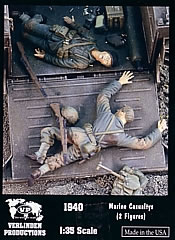| Marine
Casualties |
 |
|
While my field of interest is Army GIs, when I saw these Marine figures on the Verlinden Productions website, I was intrigued. To date there has been only one dead GI figure, an out-of-production offering from YANKS. Even though these VP figures are jarheads, their uniforms are so similar to Army garb that can be very easily adapted for a stark European setting in 1944 or 1945. Because they wear trousers and canvas leggings common to both arms of service during WWII, the main consideration is the jackets. These are very similar in length and styling to the M1943 OD jacket that was commonly seen on Army soldiers in Europe from the fall of 1944 onward. There are really no alterations needed for the soldier lying face down. For the soldier on his back, the only adjustments needed are the addition two flaps for the breast pockets, which can be done with a dab of putty. The only other questionable item is the pouch on the right hip of the solider on his back. Other web gear, canteens, etc. were universal. One helmet has the Marine camouflage cover, so you might want to swap that for another in your parts box; save it and paint it white for a Bastogne setting. The backpacks, with the bedrolls or tent halves and M1910 entrenching tool cover molded to them, are similar to the M1936 musette bags, but without the securing straps on the sides and top; it would be a stretch to use them in a European situation. Also included are VP's 1/32 scale M1 Garands, a musette bag and M1943 entrenching tool, and knives. The poses are very deathlike. After removing the narrow pour plugs on the bottoms of the figures, you might want to sand the bodies down a bit so they make more solid contact with the ground, or press them snuggly into your diorama base material. One shoe of the soldier on his back is only partially molded, so that will need to be built up if the figure is on a hard surface, or obscured with a bit of dirt or debris. The faces have an appropriate look to them. Another option is the "sleeping" heads available from Hornet, though they might be a tad small for these figures, which scale well over 6'6". Otherwise, the parts are free from flash and molding seams. The quality of the sculpting is on part with current VP figures - rather soft. A finger on one figure's hand was broken and could not be found in the plastic bag, so it will need to be repaired. It's evident from a little test-fitting of the arms that some putty may be needed to fill gaps. These
figures will be a decent addition to any diorama that wants to convey
the grim reality faced by all soldiers, whether in 1944 or 2004.
-tss- |
 |
 |
 |
 |
 |
 |
 |
 |
 |
 |
 |
 |
|
 Verlinden
Productions
Verlinden
Productions